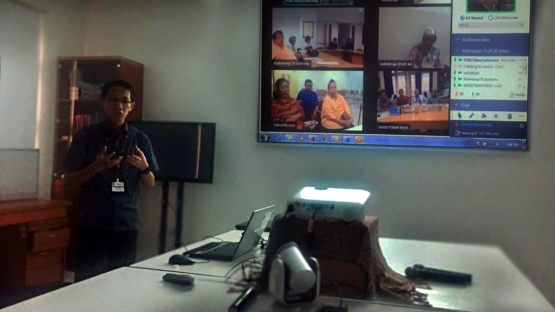Jakarta, Indonesia – When radiation oncologist Soehartati Gondhowiardjo came across a difficult case of thymic carcinoma last month, she knew she would want to share the lessons learned with her colleagues. A few weeks later, in a small conference room at the Cipto Mangunkusumo General Hospital, the largest in the country, they discussed the case. In attendance were not only her immediate colleagues, but also, watching via a teleconference system, oncologists from seven hospitals around the country.
“It is crucial that colleagues from regional centers also get exposed to difficult cases – it is a small but important step towards providing equal access to quality care to patients from across Indonesia,” said Gondhowiardjo, Professor of Radiation Oncology at the General Hospital and President of the Indonesian Radiation Oncology Society. Prof Tati, as her staff affectionately call her, initiated the telemedicine project in 2014 with a vision to eventually provide diagnosis and treatment recommendations to patients on far flung islands of the archipelago. Over 50% of cancer patients require radiotherapy for treatment or palliative care.
The IAEA, through its technical cooperation programme, has supported the initiative by providing the expertise to design the network and donating the hardware necessary for the teleconference to the eight participating hospitals. The Indonesian Radiation Oncology Society bought the software required.
“For now we are at stage 1 of the project – sharing experience,” Gondhowiardjo said. “The next step will be to provide remote advice to colleagues based on diagnostic images they send to us, and eventually to provide treatment plans fully remotely to patients in rural hospitals without specialized staff.”
Cancer is becoming a major burden in Indonesia, accounting for 1.3 million cases in 2015. The Government has responded with the development of a national cancer control programme and is adding 20 radiotherapy machines to the 60 already in use. By the end of this year, 18 of Indonesia’s 34 provinces will have at least one radiotherapy machine. “But experience and skills take a lot longer to build – this is what we are trying to overcome with teleradiotherapy,” said Gondhowiardjo.
More investment in technology is needed before oncologists and medical physicists from major hospitals like hers are able to analyze diagnostic images and provide treatment plans for their colleagues. Most of the hospitals lack the Internet bandwidth and the equipment needed to hook up to send and receive images.







